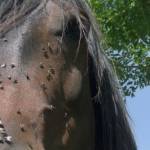Fly Larvae Aid in Wound Healing for Horses

Most horse owners consider flies to be barn pests, spreading germs and annoying horses and humans alike. There is a good side to flies, however: the newly hatched larvae of several species, chiefly the green bottle fly, are used in both humans and horses to rid wounds of bacteria and dead tissue. Also known as maggots, these immature insects have a long history of use by doctors, and their efficiency in cleaning up a wound is hard to beat.
A recent study conducted at the University of Lyon in France assessed the effectiveness of maggot debridement (removal of damaged or dead tissue) in equine lesions. The study used 41 horses with lesions of various types and locations including hoof injuries, lacerations of the limbs, abscesses, and infections. Within a week of beginning maggot therapy, the treatment proved beneficial in 93% of these cases, with good outcomes attributed to an antiseptic effect and the breakdown of biofilm formation. Maggots tended to destroy and digest bacteria, including some resistant strains, along with damaged tissue.
Though the therapy is somewhat expensive, it is an excellent choice for treatment of some types of lesions where skin is under continuous movement, such as on the lower legs of horses.








